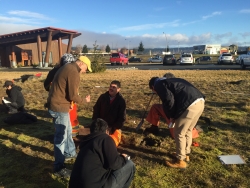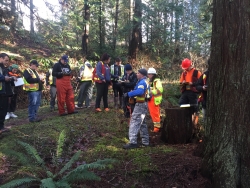LEARNING THE ROPES
Through a Vancouver Island University (VIU) community-based program, Ha-ma-yas Network Guardians and stewardship staff are learning hands-on skills to take out into the field.
“These courses are providing us with incredibly valuable knowledge,” observes Brad Seward, Projects and Tourism Manager for Mamalilikulla.
Seward, 46, is taking courses being offered through VIU’s stewardship technician training program, a three-year study program running through 2015 to 2017. As someone who grew up in his territory learning traditional ways of living, Brad also plays an invaluable role providing advice and feedback on various aspects of the program.
So far, so good, he says: “The courses are so beneficial. The students enrolled in the class range from youngsters with no experience to people like me who have been working in this field for a long time, and we are all getting value from the program. For the young people especially, things are really taking off with huge potential for their future, not only in stewardship roles but in all sorts of areas—archaeology, biology, forestry, you name it.”
A community-driven pathway
The content of the stewardship program, says VIU’s Office of Aboriginal Education and Engagement representative Sheila Cooper, is “very community-driven. We’ve worked closely with the communities to identify where the needs and desires are for courses that will support the work of the stewards and Guardians most effectively.”
The training provides university credits that can be applied to further tertiary studies and industry-recognized certificates in a range of fields. Participants can obtain qualifications in environmental assessment and monitoring of fish and fish habitat, water, soils, vegetation and wildlife, and of construction sites; certification in archaeological and culturally modified tree inventory techniques; electro-fishing certification; and BC Parks administration.
Going beyond technical training
A unique course that is offered as part of the training is in cultural awareness, working with elders from different communities. “That’s a very exciting part of the program,” says Chris Roberts of Nanwakolas Council, who worked with VIU in the development of the program. “The title of Cultural Awareness doesn’t do it justice. It is such an important aspect of the work that has to be done—knowledge of how things are supposed to be done, the history and tradition behind certain customary ways of working, and an understanding of the environment from a cultural perspective—you can’t take that for granted. It’s so important.”
Roberts is delighted that VIU was supportive of including a course like Cultural Awareness in the program: “It’s not part of a typical technical skills delivery system, so this is ground-breaking in a way. With the combination of the traditional western technical scientific skills as well as the First Nations approach to the methodology and experience, the credibility of the program is very high.”
Sheila Cooper says another unique aspect of the program is what she describes as “Indigenous portfolio development” for the students. “We help them document their qualifications and their experience, whether that has been obtained through non-traditional educational pathways or simply through the work and experiences they have had. The portfolio is intended to be a valuable asset in applying for courses or credits that usually rely on more traditional educational qualifications, so we are excited about that, too.”
K’ómoks First Nation Guardian Cory Frank is enjoying the experience so much he’d actually like more of it: “The archaeology course could be two full weeks of learning then a week in the field instead of just two weeks total,” he observes. Cory doesn’t hesitate when asked if he would recommend the courses to other First Nations people considering working in the stewardship field. “Absolutely! This is something you can use to build on for your future, your whole life, not just whatever you are doing now. I keep telling everyone, take all the courses, take everything!”
Hard work, great benefits
Participants are expected to work hard, but they have help. Greg Johnson, who works for Nanwakolas Council, acts as a community coordinator for the program. Johnson attends classes and mentors students as well as managing logistics for the programme. “Having Greg there makes a big difference,” says Cory. “He really helps everyone, gets answers to the questions if they aren’t immediately there, and keeps everyone motivated to keep going, because it is hard work, no doubt about it.”
“The work can be challenging, and the schedule, because its hands-on learning for a week, then a week in the field, while some of these students are also working. And of course, they have to get or maintain other standard prerequisite certification at the same time, like wilderness first aid and swiftwater rescue. So it’s a lot to ask of people,” acknowledges Johnson.
What makes it work, he says, are the students themselves. “The students talk a lot about how they are gaining confidence in themselves and their skills in dealing with technical methods and systems and so on, but they also talk constantly about the huge side benefit of learning alongside each other.” Participants who struggle in one area typically get a helping hand from someone who finds it easy, and vice-versa in another area: “It seems to be balancing out, and the students really appreciate each other’s support and knowledge.”
An added benefit is getting to know participants from other parts of the coast. “Mixing with each other, they are learning about how things are done elsewhere and building strong relationships that they can carry out in the field with them,” says Johnson. That’s powerful, he observes: “It’s building this strong network of people all working as stewards in their respective areas, who now know who to call when they see something that affect someone else’s area. That collaboration and coordination is good for them, and for the environment they are all working to protect.”
A world of opportunity
Brad Seward hopes more young people will see the opportunities that the program offers and sign up too. “When they see other youngsters being able to do this, drive boats, monitor the environment, talk to tourists and government officials with confidence—well, that should give them confidence they can do it too.”
“It is pretty mind-blowing to see these young people doing all these things already,” concludes Seward. “Their future is unlimited, thanks to this training program. Who knows what careers they will end up in—forestry, resource management, agriculture, archaeology—the options are endless. I'm just so happy about that.”
For more information about the VIU Stewardship Technician Training Program and how to apply for courses, contact Chris Roberts at 250-286-7200 or .



